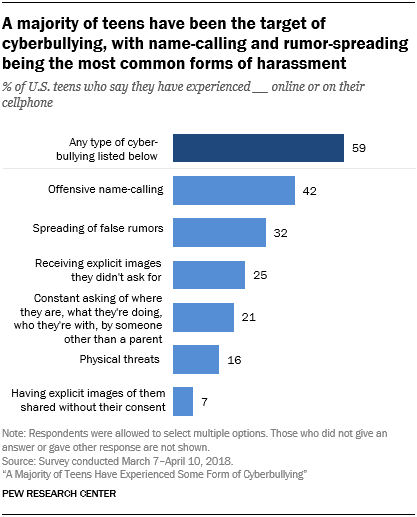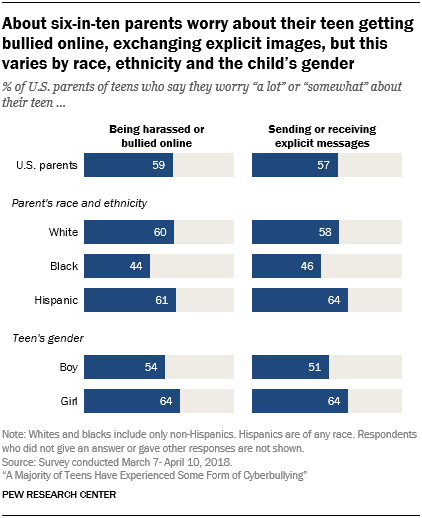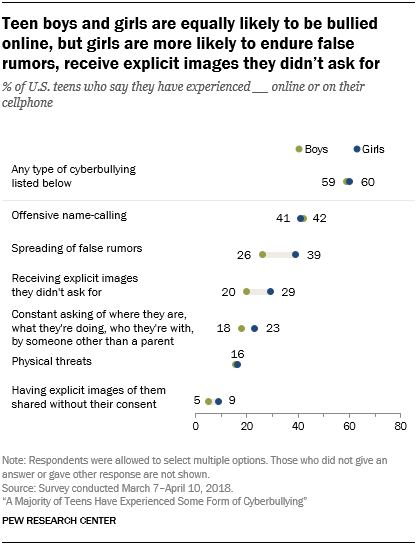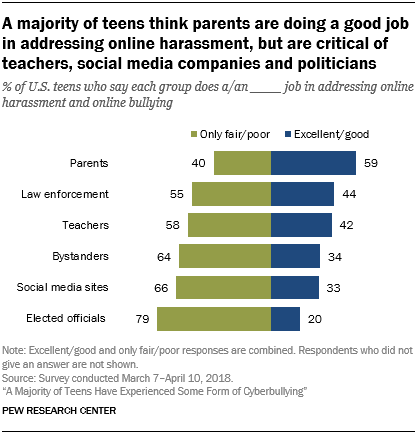Pew: A majority of U.S. teens are bullied online
A majority of U.S. teens have been subject to online abuse, according to a new study from Pew Research Center, out this morning. Specifically, that means they’ve experienced at least one of a half-dozen types of online cyberbullying, including name-calling, being subject to false rumors, receiving explicit images they didn’t ask for, having explicit images of themselves shared without their consent, physical threats, or being constantly asked about their location and activities in a stalker-ish fashion by someone who is not their parents.
Of these, name-calling and being subject to false rumors were the top two categories of abuse teens were subject to, with 42% and 32% of teens reporting it had happened to them.

Pew says that texting and digital messaging has paved the way for these types of interactions, and parents and teens alike are both aware of the dangers and concerned.
Parents, in particular, are worried about teens sending and receiving explicit images, with 57% saying that’s a concern, and a quarter of them worry about this “a lot.” And parents of girls worry more. (64% do.)

Meanwhile, a large majority – 90% – of teens now believe that online harassment is a problem and 63% say it’s what they consider a “major” problem.
Pew also found that girls and boys are both harassed online in fairly equal measure, with 60% of girls and 59% of boys reporting having experienced some sort of online abuse. That’s a figure that may surprise some. However, it’s important to clarify that this finding is about whether or not the teen had ever had experienced online abuse – not how often or how much.
Not surprisingly, Pew found that girls are more likely than boys to have experienced two or more types of abuse, and 15% of girls have been the target of at least 4 types of abuse, compared with 6% of boys.
Girls are also more likely to be the recipient of explicit images they didn’t ask for, as 29% of teens girls reported this happened to them, versus 20% of boys.
And as the teen girls get older, they receive even more of these types of images, with 35% of girls ages 15 to 17 saying they received them, compared with only 1 out of 5 boys.

Several factors seem to play no role in whether the teens experience abuse, including race, ethnicity, or parents’ educational attainment, Pew noted. But having money does seem to matter somehow – as 24% of teens whose household income was less than $30K per year said they received online threats, compared with only 12% of those whose household incomes was greater than $75K per year. (Pew’s report doesn’t attempt to explain this finding.)
Beyond that factor, receiving or avoiding abuse is directly tied to how much screen time teens put in.
That is, the more teens go online, the more abuse they’ll receive.
Forty-five percent of teens say they’re online almost constantly, and they are more likely to be harassed, as a result. Sixty-seven percent of them say they’ve been cyberbullied, compared with 53% who use the internet several times a day or less. And half the constantly online teens have been called offensive names, compared with just about a third (36%) who use the internet less often.
Major tech companies, including Apple, Google, and Facebook, have begun to address the issues around device addiction and screen time with software updates and parental controls.
Apple, in iOS 12, rolled out Screen Time controls that allows Apple device users to measure, monitor and restrict how often they’re on their phones, when, what type of content is blocked, and which apps they can use. In adults, the software can nudge them in the right direction, but parents also have the option of locking down their children’s phones using Screen Time controls. (Of course, savvy kids have already found the loopholes to avoid this, according to new reports.)
Google also introduced time management controls in the new version of Android, and offers parental controls around screen time through its Family Link software.
And both Google and Facebook have begun to introduce screen time reminders and settings for addictive apps like YouTube, Facebook and Instagram.
Teens seem to respect parents’ involvement in their digital lives, the report also found.

A majority – 59% – of U.S. teens say their parents are doing a good job with regard to addressing online harassment. However, 79% say elected officials are failing to protect them through legislation, 66% say social media sites are doing a poor job at stamping down abuse, and 58% of teachers are doing a poor job at handling abuse, as well.
Many of the top media sites were largely built by young people when they were first founded, and those people were often men. The sites were created in an almost naive fashion, with regard to online abuse. Protections – like muting, filters, blocking, and reporting – were generally introduced in a reactive fashion, not as proactive controls.
Instagram, for example – one of teens’ most-used apps – only introduced comment filters, blocklists, and comment blocking in 2016, and just four months ago added account muting. The app was launched in October 2010.
Pew’s findings indicate that parents would do well by their kids by using screen time management and control systems – not simply to stop their teenagers from being bullied and abused as often, but also to help the teens practice how to interact with the web in a less addictive fashion as they grow into adults.
After all, device addiction resulting in increased exposure to online abuse is not a plague that only affects teens.
Pew’s full study involves surveys of 743 teens and 1,058 parents living in the U.S. conducted March 7 to April 10, 2018. It counted “teens” as those ages 13 to 17, and “parents of teens” are those who are the parent or guardian of someone in that age range. The full report is here.
Contributer : Social – TechCrunch
 Reviewed by mimisabreena
on
Friday, September 28, 2018
Rating:
Reviewed by mimisabreena
on
Friday, September 28, 2018
Rating:
















No comments:
Post a Comment